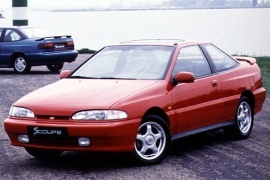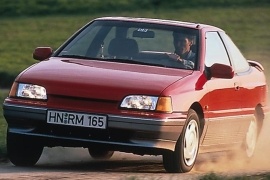HYUNDAI Scoupe Models/Series Timeline, Specifications & Photos
First production year: 1990
Engines: Gasoline
Body style: Coupé (two-door)
Hyundai refreshed the S-Coupe, or Scoupe, after just two years since it introduced it on the market, and besides some visual changes, it introduced brand new engines.
While the 1990 S-Coupe looked almost unfinished, with some rough edges here and there, the facelifted version was closer to a well-finished vehicle. Even though it shared the same platform with Hyundai Excel, it offered a stiffer suspension.
The car sported a new front fascia with sleeker headlights flush to the grille and curved lines. Since the front fenders had to be replaced, the carmaker emphasized the sidelines, making the car look wider. In the back, the redesigned taillights featured smoked lenses for the reversing lights and a reshaped trunk lid. Hyundai added a third brake light in the rear wing.
Inside, the instrument cluster was tall, curved toward the driver, and wide. It covered the center stack as well. A large tachometer was placed on the left side of the panel, giving a sporty feeling to the driver. The front bucket seats featured some bolstering, but not too much. It was more for the look than for hold occupants during high-speed cornering. Hyundai offered room for four adults in the S-Coupe, but it was not that roomy in the back-seats. It was more of a two-adults plus two-kids vehicle.
Under the hood, Hyundai installed its newly developed Alpha engine, with or without a turbocharger. The Korean carmaker worked hard to make the tiny 1.5-liter more punchy, but not too much. In the naturally-aspirated version, the carmaker paired it to either a five-speed manual or a four-speed automatic. At the same time, Hyundai offered the turbocharged version exclusively with a five-speed manual.
With an increasing demand for affordable coupe vehicles, Hyundai tried to offer a small coupe on the market, based on the second generation of the Excel.
In 1990, Hyundai was still far behind other carmakers. The Korean carmaker was still struggling to catch-up, but with Mitsubishi's help, its rapid development started to be seen. It was like the magic car-company that rapidly increased its market share. The Scoupe was Hyundai's idea to compete against vehicles such as the Honda Civic, Nissan Pulsar NX, or Toyota Tercel.
While the design lacked consistency, and the front of the car didn't seem to match the rest of it, the Scoupe was a good testing bench for the Korean carmaker. Its boxy design with rounded edges was something new for its creative department. But the designers succeeded in hiding the C-pillar between the side and rear windows. In the rear, the wide taillights covered the quarter panels' back and a part of the decklid.
Inside, the instrument cluster was tall, curved toward the driver, and wide. It covered the center stack as well. A large tachometer was placed on the left side of the panel, giving a sporty feeling to the driver. The car offered room for four, but there was room only for two in the back.
Under the hood, Hyundai installed a 1.5-liter engine from Mitsubishi. It was paired to a standard 5-speed manual transmission. After 1993, the carmaker improved the Scoupe and kept it in production until 1996.

